2017 | Author: Federal Foreign Office & Initiative Mediation Support Deutschland (IMSD)
Basics of Mediation: Concepts and Definitions
Fact Sheet Series: Peace Mediation and Mediation Support
2017 | Author: Federal Foreign Office & Initiative Mediation Support Deutschland (IMSD)
Fact Sheet Series: Peace Mediation and Mediation Support
2016 | Author: Watchlist on Children and Armed Conflict
Also read in Arabic, Spanish, French. This checklist developed by ‘Watchlist on Children and Armed Conflict’ provides recommendations to mediators and their teams, which can assist in incorporating inclusive and child protection-relevant language and provisions in various parts of peace agreements. The recommendations are offered in full recognition that peace agreements are context specific and that what is achievable and desirable will depend on circumstances.
2015 | Author: United Nations, European Union
This Guidance Note builds on the experience of the UN and the EU in supporting national counterparts in preventing and resolving violent tensions, and and is the first attempt to document and distill best practices on supporting insider mediators. Unlike external mediation, insider mediation draws upon the abilities of institutions or individuals that are seen as “insiders” within a given context to broker differences, build consensus, and resolve conflict.

2015 | Author: Vicenc Fisas, School for a Culture of Peace, Universitat Autonoma de Barcelona
This tenth edition of the Yearbook on Peace Processes analyses conflicts in which negotiations are being held to reach a peace agreement, regardless of whether these negotiations are formalised, are in the exploratory phase, are faring well or, to the contrary, are stalled or in the midst of crisis. It also analyses some cases in which negotiations or explorations are partial; that is, they do not include all the armed groups present in the country (such as the case of India, for example). The majority of the negotiations refer to armed conflicts, but we also analyse quite a few contexts in which, despite the fact that there are no considerable armed clashes today, the parties have not reached a permanent agreement that would put an end to the hostilities and conflicts still pending. In that sense, the negotiations make sense in an effort to fend off the start or resurgence of new armed clashes.

2014 | Author: Vicenc Fisas, School for a Culture of Peace, Universitat Autonoma de Barcelona
This ninth edition of the Yearbook on Peace Processes analyzes conflicts in which negotiations are being held to reach a peace agreement, regardless of whether these negotiations are formalized, are in the exploratory phase, are faring well or, to the contrary, are stalled or in the midst of crisis. It also analyses some cases in which negotiations or explorations are partial; that is, they do not include all the armed groups present in the country (such as the case of India, for example). The majority of the negotiations refer to armed conflicts, but we also analyze quite a few contexts in which, despite the fact that there are no considerable armed clashes today, the parties have not reached a permanent agreement that would put an end to the hostilities and conflicts still pending. In that sense, the negotiations make sense in an effort to fend off the start or resurgence of new armed clashes.

2014 | Author: Alexander Ramsbotham and Achim Wennmann
This 6-page policy brief summarizes the findings of Accord 25 - Legitimacy and peace processes: from coercion to consent. It argues that a legitimacy lens should be applied to peace processes by paying attention to priorities of context, consent and change.

2014 | Author: Alexander Ramsbotham and Achim Wennmann
The 25th edition of the Accord series focuses on legitimacy and the practical ways that it can contribute to building more sustainable peace. It looks at 15 country case studies at various stages of conflict, including the Philippines, Syria, Afghanistan, the Basque Country, Somaliland, Yemen and Burma. These case studies focus on four types of peacebuilding activity: national dialogue, constitutional review, local governance and transforming coercive actors
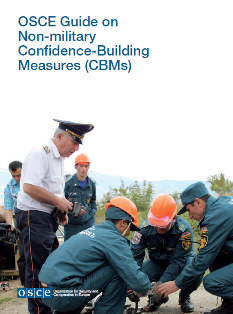
2012 | Author: Organization for Security and Co-operation in Europe (OSCE)
This Guide is destined to policymakers and practitioners seeking to develop and implement effective CBMs. The first chapter lays out the conceptual framework, covering, inter alia, what non-military CBMs are, their historical development, their relationship with CSBMs and other conflict-related measures as well as the nature, characteristics and limitations of CBMs. The second chapter includes practical guidance on developing and implementing CBMs. Finally, the third chapter includes ten examples of past and current CBMs implemented by the OSCE in its different regions and dimensions.
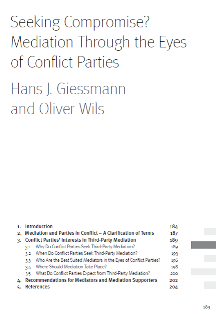
2011 | Author: H.J. Giessmann, O.Wils (Berghof Foundation)
This paper looks at mediation through the eyes of the conflict parties. By shedding some light on the stakeholders’ motivation to consider third-party mediation a viable option, the paper intends to bring added value to the ongoing discourse on how to make mediation an effective approach to conflict transformation. The paper also elaborates on the core interests of conflict parties in third-party mediation and proposes recommendations for practice and research in mediation or mediation support.
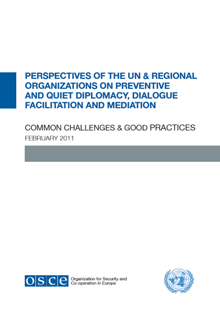
2011 | Author: Organization for Security and Co-operation in Europe (OSCE)
This report reflects the main issues discussed during a workshop on “Preventive and Quiet Diplomacy, Dialogue Facilitation and Mediation – Best Practices from Regional Organizations 1” held in co-operation with the United Nations’ Department of Political Affairs in December 2010. The report identifies common challenges to mediation faced by regional organizations as well as good practices. Opportunities for closer co-operation among regional organizations on the issue of mediation support are also suggested.
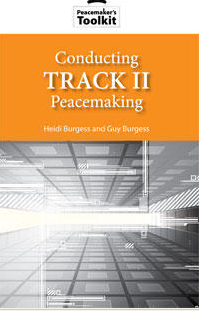
2010 | Author: H.Burgess, G.Burgess (United States Institute of Peace – USIP)
This handbook is written for both track I and track II actors. It illuminates the role and importance of track II activities; charts a wide range of track II activities, from assessment, conception, and planning to implementation and evaluation; and discusses the need for ensuring that different peacemaking efforts complement and reinforce one another.
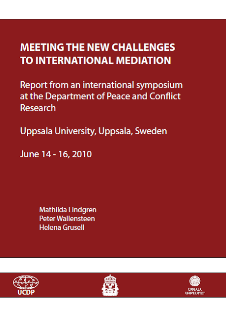
2010 | Author: M. Lindgren, P. Wallensteen, H. Grusell (Uppsala University)
This paper presents the discussions of the Uppsala symposium on Mediation in June 2010 which highlighted a number of issues novel either to researchers or to practitioners. For the purpose of this conference eight themes based on recent research were identified, inter alia pointing to the importance of the mandate for mediation, the resources available for the mediators (including research-based insights into local situations as well as into process issues), the difference between humanitarian and political mediation, the coordination of separate mediation efforts, the impact of unexpected events, ways of measuring mediation outcomes and the mediator’s responsibility for what happens in the post-accord period.
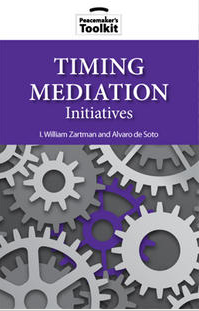
2010 | Author: I.W.Zartman, A.de Soto (United States Institute of Peace - USIP)
This toolkit lays out the steps mediators can take to recognize if a conflict is ripe for negotiation, foster the parties’ perception of ripeness, and to ripen the conflict. Step 1 describes how the mediator should assess whether a mutually hurting stalemate exists. Step 2 focuses on assessing the parties’ perception of a way out. Step 3 presents measures the mediator can take to induce the parties’ perception of a stalemate and a way out. Step 4 explains how to enhance objective conditions for ripeness, creating a stalemate and the pain associated with it as a basis for further efforts to encourage the perception of the new facts. If ripening is not possible, Step 5, involves the mediator positioning so that the parties recognize that they can turn to the mediator for help when the situation eventually becomes ripe.
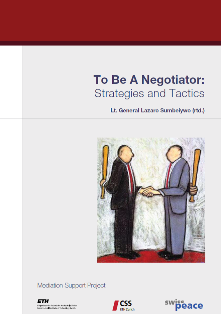
2009 | Author: Lt. General L.Sumbeiywo (CSS, ETH Zurich, Swisspeace)
This article covers the main issues involved in preparation for negotiations, as well as the strategies and tactics of a negotiator during the negotiations phase, while also addressing, in parallel, the necessary qualities of a good negotiator.
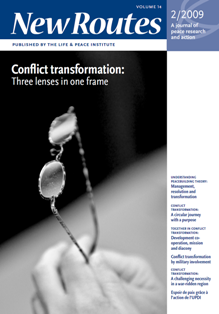
2009 | Author: New Routes/Life & Peace Institute
The aim of this publication is to reflect on different aspects of conflict transformation, to explain its basic theory, to compare it with other approaches to peacebuilding and to describe its effects in reality.
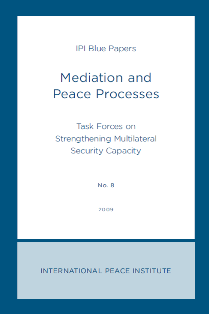
2008 | Author: Task Forces on Strengthening Multilateral Security Capacity (International Peace Institute)
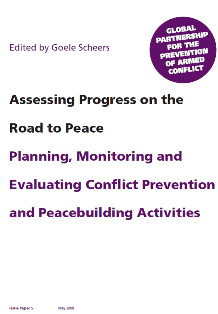
2008 | Author: European Centre for Conflict Prevention
This paper highlights the multiple challenges faced with planning, monitoring and evaluating conflict prevention activities and examines some options in dealing with these challenges.
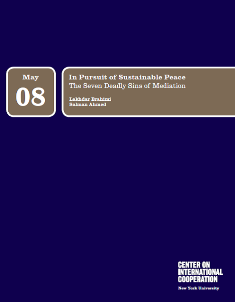
2008 | Author: L.Brahimi, S.Ahmed
This article presents seven mistakes often committed in peace processes and are referred to as ‘the seven deadly sins.’ These are: ignorance; arrogance; partiality; impotence; haste; inflexibility; and false promises.
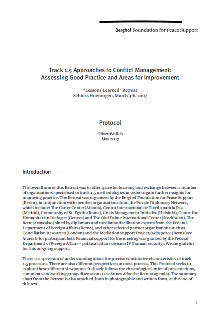
2007 | Author: O.Wolleh (Berghof Foundation for Peace Support)
This Protocol is the outcome the lessons learned Retreat organised by the Berghof Foundation for Peace Support in Schloss Hueningen (4-6 March 2007). The overall aim of this Retreat was to offer space for learning and exchange between a number of organisations specialised in track 1.5 methodologies in order to gain further insights for improving practice. This Protocol seeks to explore the different viewpoints about the precise constitutive characteristics of track 1.5 processes.
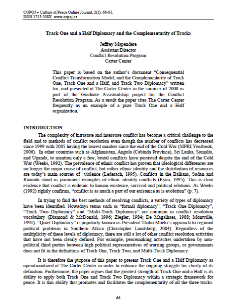
2007 | Author: J.Mapendere
This paper presents Track One and a Half Diplomacy as operationalized at The Carter Center in order to enhance the ongoing struggle for clarity of its definition. Furthermore, the paper argues that the greatest strength of Track One and a Half is its ability to apply both Track One and Track Two Diplomacy within a strategic framework for peace.
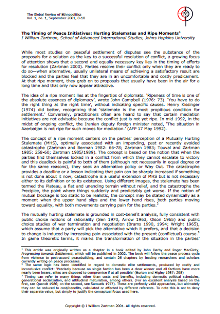
2001 | Author: W.Zartman (The Global Review of Ethnopolitics)
This article is about the timing of resolution efforts in international conflicts. It identifies strategies for finding the right moment to gain entry into a conflict, and demonstrates that negotiation efforts cannot have any success when the third-party mediators do not take ripeness into consideration.
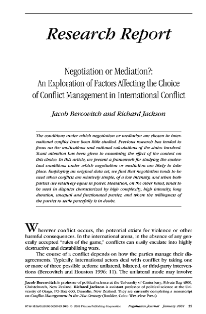
2001 | Author: J.Bercovich, R.Jackson (Negotiation Journal)
The conditions under which negotiation or mediation are chosen in international conflict have been neglected by research, which has tended to focus on the motivations and rational calculations of the states involved. Employing an original data set, the authors find that negotiation tends to be used when conflicts are relatively simple, of a low intensity, and when both parties are relatively equal in power. Mediation, on the other hand, tends to be used in complex, protracted and more high-intensity disputes between unequal and less cooperative parties.
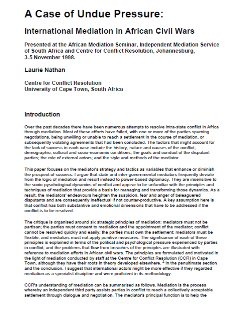
1998 | Author: L.Nathan (Centre for Conflict Resolution)
This paper focuses on the mediator's strategy and tactics as variables that enhance or diminish the prospect of success. The critique is organised around six strategic principles of mediation: mediators must not be partisan; the parties must consent to mediation and the appointment of the mediator; conflict cannot be resolved quickly and easily; the parties must own the settlement; mediators must be flexible; and mediators must not apply punitive measures. The significance of each of these principles is explained in terms of the political and psychological pressure experienced by parties in conflict, and the problems that flow from breaches of the principles are illustrated with reference to mediation efforts in African civil wars.
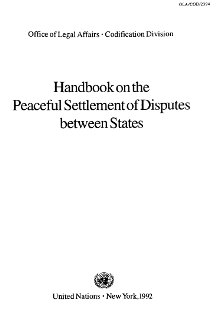
1992 | Author: United Nations (Office of Legal Affairs)
The purpose of the handbook is to contribute to the peaceful settlement of disputes between States and to help to increase compliance with international law by providing States parties to a dispute, particularly those States which do not have the benefit of long-established and experienced legal departments, with the information they might need to select and apply procedures best suited to the settlement of particular disputes. The handbook has been prepared in strict conformity with the Charter of the United Nations.